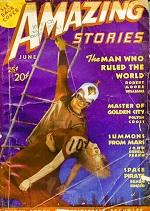The Invisible Bomber
- by Ralph Milne Farley
- Short Story
- Science Fiction
- Adults
- Definite Time Travel
- English
- “The Invisible Bomber,” as by Lt. John Pease, in Amazing, June 1938.
Here’s a new rule about what constitutes a time-travel story: If the author claims that there’s time travel in the story, then it’s a time-travel story. That’s the case for this story, which doesn’t feel like time travel to me, but in the afterward of The Omnibus of Time Farley says that the airplane bomber in this story becomes soundless and invisible via a “laminated” model of space-time in which a series of different worlds are stacked one on top of another, each just a short time in front of its predecessor. According to Farley, “time-traveling will carry the traveler, not into the future, but rather into an entirely different space-time continuum than our own.” The plane becomes invisible by traveling just a short distance toward the next world without reaching anywhere near it.
My thought on this is that the notion of time as a dimension does not have anything to do with the stacking dimension. In fact, I don’t think they can be the same dimension because that would imply that there is nothing to distinguish a point in our space-time continuum from a point with the same space-time coordinates in some other continuum.
P.S. I also didn’t care for the president’s solution to the story’s problem.
My thought on this is that the notion of time as a dimension does not have anything to do with the stacking dimension. In fact, I don’t think they can be the same dimension because that would imply that there is nothing to distinguish a point in our space-time continuum from a point with the same space-time coordinates in some other continuum.
P.S. I also didn’t care for the president’s solution to the story’s problem.
We human beings live in a three dimensional space, or which time has sometimes been called the fourth dimension. But did it ever occur to you, Mr. President, that we do not extend in time. We never experience any other time than the present. Our so-called space-time existence is thus seen to be a mere three-dimensional layer, or lamina, infinitely thin in the time direction. There could exist another three-dimensional space just a second or two away from ours, and we would never know it.

Tags
(1)
- Groupings
Variants
(1)
- “The Invisible Bomber,” as by Lt. John Pease, in Amazing, June 1938.. . . . . . . . . . . . . . . . . . . . . . . . . . . . . . . written by Ralph Milne Farley as by Lt. John Pease
